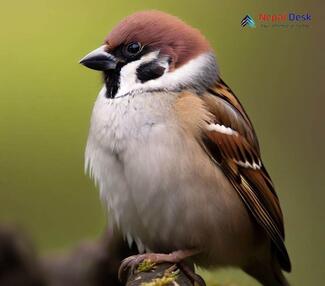The Tree Sparrow, also known as Passer montanus, is a delightful little songbird admired for its captivating looks and sweet melodies. In this article, we'll uncover various aspects of this intriguing bird species, delving into its classification, physical traits, habitat preferences, diet, and presence in the magnificent country of Nepal.
Taxonomy and Their Physical Features
As members of the Passeridae family within the Passeriformes order, Tree Sparrows are part of the Passer genus and are scientifically referred to as Passer montanus.
Grown-up Tree Sparrows can be recognized by their unique head pattern that consists of a chestnut-colored crown and nape, white cheeks, and black eye patches that create an eye-catching contrast. They sport a blend of brown and black streaks on their upper body while bearing pale grey to buff underparts. Slightly smaller than house sparrows, they measure about 12-14 cm in length with a wingspan that spans from 21 to 25 cm.
Habitat Preferences
These birds favor habitats such as woodland edges, hedgerows, farmland, orchards, and gardens. They're quite adaptable to human presence and can often be seen in rural areas as well as suburban neighborhoods. While not as reliant on human settlements as House Sparrows are, Tree Sparrows also thrive in open country settings with suitable breeding locations.
Dietary Habits
Tree Sparrows mostly munch on seeds from various plants. However, during breeding season when their growing chicks need ample protein intake, they also feast on insects. In certain places where agricultural practices limit the availability of natural seeds, Tree Sparrows have been observed to snack on grains and other crop seeds.
Spotting Tree Sparrows in Nepal
Nepal boasts a myriad of bird species, and the Tree Sparrow is no exception. They can be found throughout the country's lower elevations, from the Terai plains to mid-hills up to an altitude of 2,000 meters. Although they have adapted well to various habitats in Nepal, their populations may be impacted by deforestation and habitat loss due to urbanization and agricultural growth. In Nepal, you can typically spot these birds around cities such as Kathmandu and Pokhara, farmland areas, and rural villages.
In closing, the enchanting Tree Sparrow (Passer montanus) adds a special touch to the biodiversity of many countries including Nepal. Their alluring appearance and adaptability make them an intriguing species worth studying and preserving for future generations. By learning more about these unique birds, we not only contribute to harmonious coexistence with nature but also deepen our understanding of the interconnectedness within ecosystems.




